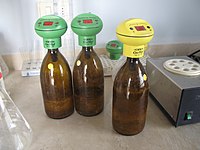
Photo from wikipedia
Abstract The growth of high-quality ZnO bulk crystals is an outstanding challenge, and the nature of grown-in defects in crystals is far from well understood. In this work, a specially… Click to show full abstract
Abstract The growth of high-quality ZnO bulk crystals is an outstanding challenge, and the nature of grown-in defects in crystals is far from well understood. In this work, a specially designed low-temperature-gradient CVT growth system was developed based on finite element analysis. High-quality ZnO single crystals were successfully grown. The supersaturation front in the growth system was controlled, and internal stress in the crystal was reduced by introducing a radiation baffle and a special seed pedestal. The structural, electrical, and optical properties of ZnO crystals were studied before and after oxygen annealing. The scanning electron microscope (SEM) and optical microscope (OM) results indicate the stable growth is achieved under the Zn-rich growth condition. The X-ray rocking curve measurements reveal the high crystalline quality of the grown crystal with the full-width at half-maximum (FWHM) value of 17 arcsec for the (004) reflection. The time-of-flight secondary ion mass spectroscopy (ToF-SIMS) results prove the high purity of grown crystals and reveal the variations of trace impurity concentrations in crystals. When annealed in oxygen at 1000 °C, the optical band gap (Eg) changes from 2.50 eV to 3.15 eV. The Raman analysis indicates that oxygen vacancies (Vo) in the as-grown crystal disappear after annealing. The Hall measurements show that the room temperature (RT) mobilities before and after annealing are 197 cm2V−1c−1 and 207 cm2V−1c−1, respectively. The RT carrier concentration decreases by about two orders of magnitude to 5.45 × 1015 cm−3, while the RT resistivity increases by about one order of magnitude to 5.57 Ω cm after annealing. The positron annihilation lifetimes (PALS) results prove the presence of Zn vacancies (Vzn) after annealing. The origins of as-grown ZnO green luminescence (GL) and the temperature-dependent blue shifts of the GL peak positions are explained based on Zni and Vo defects. The fine structures of annealed ZnO GL are found to be related to Vzn native defects rather than Cu impurity.
Journal Title: Ceramics International
Year Published: 2020
Link to full text (if available)
Share on Social Media: Sign Up to like & get
recommendations!